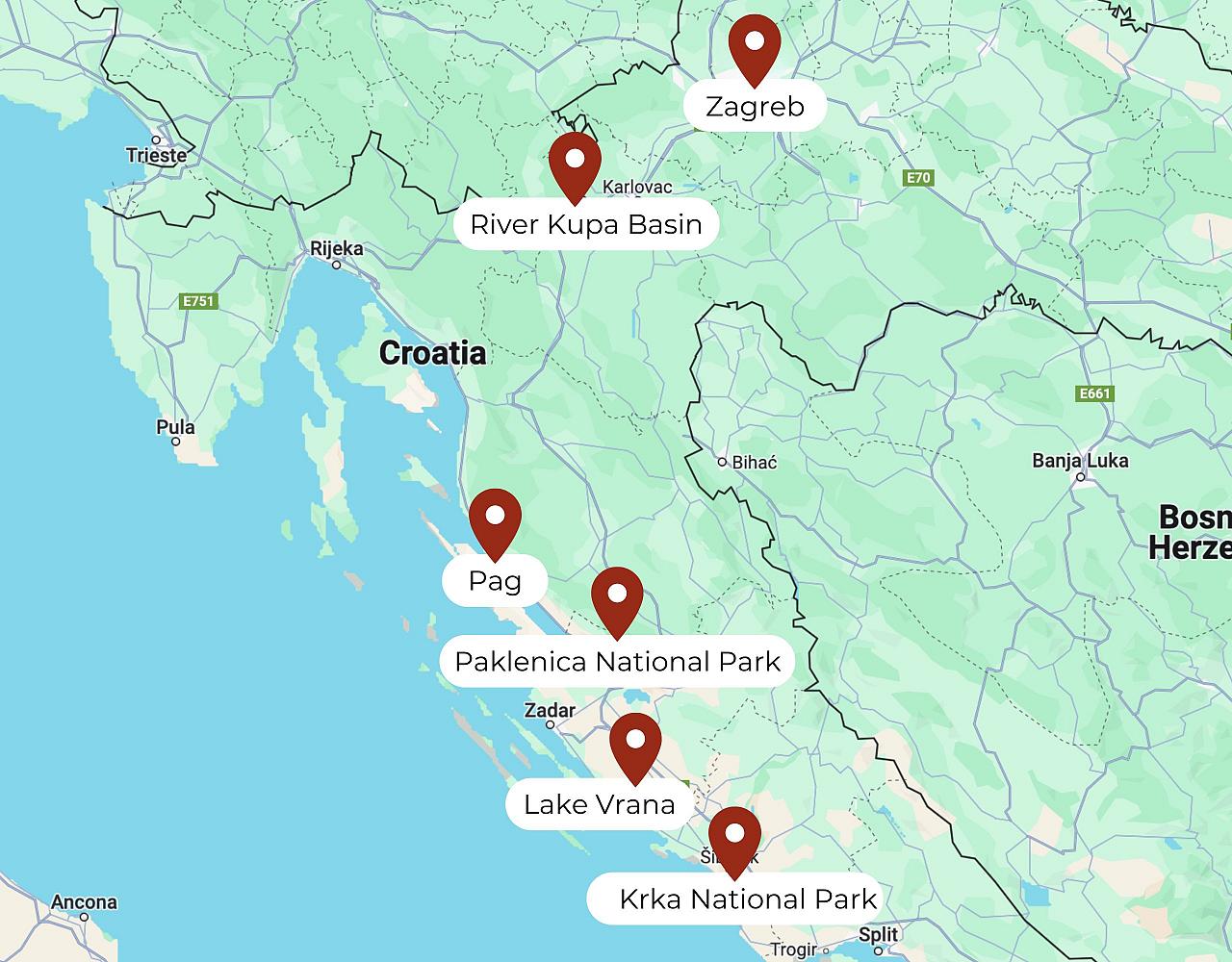- Overview
- Full Itinerary
- Photo Gallery
- Costing
- Travel Details
- Guide
- Map
- Know Before You Go
- Other Trips You May Like
This NEW! tour to Croatia focuses on the birds and other wildlife of this stunningly scenic country in the west of the Balkan peninsula. April is a great time to visit; in addition to resident species, birds that breed further north in Europe are heading back on spring migration, following the coastline of the Adriatic Sea. We journey through and explore remarkably diverse landscapes, from the green pastures, meadows, and broadleaved woodlands of the Kupa Basin in the north, to the picturesque waterfalls of Krka and the craggy gorges of Paklenica in Dalmatia. The blue waters of the Adriatic are never far away.
We take our time, following the lead of the rural folk who often still work the land in unhurried and traditional ways. We also explore Croatia’s rich history and take in several sites from Slavic, Roman, Venetian, and Turkish cultures on our journey. Sample authentic local dishes and taste fine local wines on this Croatia birding and nature tour. Join us and our expert regional guide Gerard Gorman, who has been visiting Croatia for decades … be prepared for a wealth of memorable sightings and marvelous experiences.

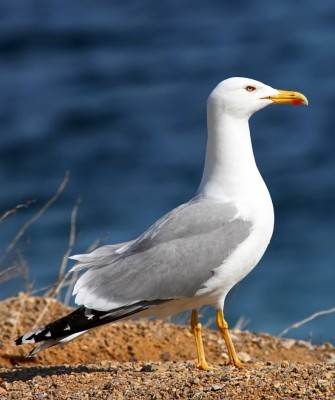
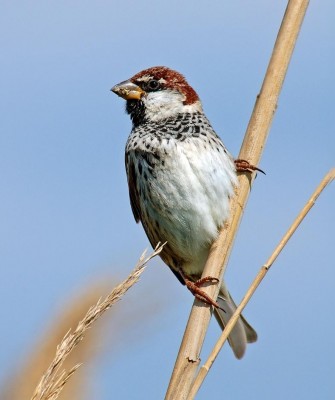

Tour Highlights
- Explore the local woodlands, wetlands, and farmlands of the River Kupa Basin looking for White and Black Storks and raptors
- Enjoy slow birding en route to the Dalmatian Coast and beautiful Krka National Park
- Walk through ancient Skradin, soaking in local architecture and looking for Blue Rock Thrush and Eurasian Scops Owl
- Witness the stunning Skradinski Buk, a series of stepped cascades
- Spend time at Lake Vrana, the largest lake in the country, before exploring the Nin saltpans and the old-city of Nin
- Relax for three nights on the Island of Pag in the stunning Adriatic; birding and stunning landscapes abound
- Take two full days to explore Paklenica National Park, a picturesque area between the Adriatic and the rugged Velebit Mountain range




Trip Itinerary
Itineraries are guidelines; variations in itinerary may occur to account for weather, road conditions, closures, etc. and to maximize your experience.
Tues., Apr. 8 Arrivals
Welcome to Croatia! We encourage you to come in a bit early to rest up from your travels and enjoy a casual dinner or drink with your guide and fellow travellers. Please plan on taking a taxi to the Hotel AS.
Accommodations at Hotel AS, Zagreb
Wed., Apr. 9 Local Birding in the River Kupa Basin
Not far from the city we begin by exploring the local woodlands, wetlands, and farmlands of the River Kupa Basin. Here we see White Stork, already on their huge stick nests on rooftops and roadside utility poles, perhaps a Black Stork or two, and raptors such as White-tailed Eagle, Eurasian Sparrowhawk, Red and Black Kites, and Western Marsh Harrier. Corvids include Hooded Crow, Eurasian Jackdaw, Eurasian Magpie, and Eurasian Jay. At a local fish-farm, ducks such as Garganey, Gadwall, and Eurasian Wigeon are all possible, along with Great Crested and Little Grebes, Eurasian Coot, and various herons. Eurasian Skylark are singing and there are warblers such as Eurasian Blackcap, Common Chiffchaff, and Wood Warbler and “reedy” species like Savi’s Warbler. On the mammal front, we should find Brown Hare and Roe Deer, and see signs of European Beaver. Beautiful Fire-bellied Toad should be “in song”, too. Our first two nights are in a small town to the west of the capital.
Accommodations at Hotel Amarilis, Netretic (B,L,D)
Thurs., Apr. 10 Local Birding in the River Kupa Basin
We have a full day to explore the varied habitats of this region—ponds, reedbeds, broadleaved woodlands, parkland, and pleasant open country of pastures and meadows which are still farmed by the locals in a low-intensity manner. We may return to the River Kupa area or walk in woodlands, orchards, and vineyards near our hotel, or do a combination. Wherever we go, we are not in a rush. We take several short, quite easy walks on the flat paths and in the middle of the day have a picnic in a pleasant spot. Birds should include Gray Heron, Great and Little Egrets, Great Crested and Little Grebes, Black-headed Gull, Black and Whiskered Terns, Northern Lapwing, and Eurasian Curlew. Grey-headed, European Green, Middle Spotted, Lesser Spotted, Great Spotted, and Black Woodpeckers and the weird and wonderful Eurasian Wryneck are possible, too. Passerines here include White Wagtail, Collared and Spotted Flycatchers, Common and Lesser Whitethroats, Short-toed Treecreeper, Eurasian Tree Sparrows, Serin, Linnet, and Hawfinch. The iconic Common Cuckoo is another bird we should come across today.
Accommodations at Hotel Amarilis, Netretic (B,L,D)
Fri., Apr. 11 Birding en route to Krka National Park
Today we head south towards the Dalmatian Coast, our final destination being the beautiful Krka National Park. We make many stops as we go, to watch birds and other wildlife, and enjoy the inspiring landscapes. We should see Eurasian Hoopoe, Whinchat, European Stonechat, Corn Bunting, Woodlark, and European Turtle-Dove. We also keep an eye open for flocks of European Bee-eater and Red-footed Falcon, especially on roadside wires. We arrive at our hotel in the quaint little port town of Skradin, which nestles right by the park. In the late afternoon, we check in for a three night stay. After the lusher, greener north, Dalmatia definitely has a Mediterranean feel, as the azure Adriatic Sea is never far away. The default large larid hereabouts is Yellow-legged Gull, and we see the first of many. Skradin has a rich history that goes back some 2000 years to the time of the Illyrians. Later, Romans, Goths, Venetians and Ottomans ruled here in turn. The ruined Turina Fortress, which was built between 1273 – 1312, sits high over the town. Today’s name “Skradin” derives from the Roman “Scardona”. Today, this small town’s historical centre, with its charming narrow cobbled streets and buildings from the 17th and 18th Centuries, is a protected national monument because of its historical heritage. It is a wonderful place for us to be based. For example, the Church of the Mother of God (Crkva Male Gospe) has a bell tower from which a Blue Rock Thrush often sings! In the evening, we listen for calling Eurasian Scops Owl, which are often in the town itself, and hopefully even see one of these tiny owls.
Accommodations at Hotel Skradinski Bukin, Skradin (B,L,D)
Sat., Apr. 12 & Sun., Apr. 13 Krka National Park
We have two full days in and around Krka National Park. This is a splendid and impressive area, a karstic limestone plateau, with arid macchia scrub, wet meadows, and broadleaved forests through which the River Krka flows. There are gorges, crags, and small waterfalls and a valuable range of fauna and flora. Blue Rock Thrush, Western House Martin, European Serin and colonies of Spanish Sparrow can often be found near our hotel. Krka is a good area for birds of prey with Eurasian Hobby and Short-toed and Golden Eagles possible. Two lovely spots we visit are the small waterfalls at Roški Slap and Skradinski Buk where Pygmy Cormorant, Gray Wagtail, Common Nightingale, and Cetti's Warbler are not uncommon. We reach Skradinski Buk, which is actually not one high waterfall but a series of stepped cascades, on a comfortable twenty minute boat ride up the river Krka. Dragonflies and damselflies are often abundant here. Away from the water, rocky and scrubby habitats are home to Eastern Black-eared Wheatear, Western Rock Nuthatch, Black Redstart, Eurasian Crag Martin, Alpine and Common Swifts, and Subalpine and Eastern Sardinian Warblers. Rock Partridge, one of the birds for which Croatia is famed in birding circles, is also likely here. Other wildlife at Krka includes twenty-two species of reptiles, such as Hermann's Tortoise, European Pond Terrapin, Italian and Dalmatian Wall Lizards, Sharp-snouted Rock Lizard, and the larger Balkan Green Lizard, which can reach around half a metre in length. Snakes include two aquatic species, Grass Snake and Dice Snake. If we are fortunate, we might even come across a European Rat-snake, arguably the most attractive species here. Amphibians include Marsh and Agile Frogs and European Green Toad.
Accommodations at Hotel Skradinski Bukin, Skradin (B,L,D)
Mon., Apr. 14 Lake Vrana | Nin Salt Pans | Nin Old Town | Island of Pag
After breakfast we head north along the very scenic Adriatic coast road. We spend time by Lake Vrana (Vransko jezero in Croatian), which is the largest natural lake in Croatia at around 9 miles long and 2 miles wide. In some places it is separated from the sea by just an 800 metre strip of land. Its reedbeds and open water are important for both breeding and migrating birds, with April being particularly good for passage species. A key species here is Pygmy Cormorant and there should also be grebes, gulls, terns, herons, and wildfowl. Warblers include Great Reed, Common Reed, Cetti’s, Savi’s, and Zitting Cisticola. Our next stop is at salt-pans by the town of Nin. We can expect a range of passage shorebirds with Ruff, Dunlin, Kentish Plover, Little Stint, Marsh, Wood and Green Sandpipers, Common Greenshank, Common Redshank, and Pied Avocets all possible. Black-winged Stilt nest on the shallow saline basins. We may even spot a rarity … it’s that kind of place. Salt production is the oldest economic activity in Nin and salt is still created here using traditional methods. The town of Nin was founded by an Illyrian tribe, the Liburnians in the 9th Century BC. Later, during Roman times, it was an important port. Indeed, it was always a strategic site and thus ransacked several times in its history, before being totally destroyed in 1646 by the Ottomans. Nin is also the oldest Croatian royal town, a place where seven Croatian kings were crowned. When we have finished at the salt-pans we take a look at the old town. In the late afternoon we cross onto the island of Pag, via a road bridge, where we spend the next three nights.
Accommodations at Hotel Intermezzo, Pag (B,L,D)
Tues., Apr. 15 & Wed., Apr. 16 Island of Pag
Pag is the fifth largest of Croatia’s islands and overall has the longest coastline. Much of the interior is remarkably barren-looking, often stony terrain, though there is macchia scrub, vineyards, olive-groves, salt-pans, and bush-dotted, grass-sage grazing land; we certainly make time to sample the local sheep’s cheese which has a distinct flavour of sage. Old stone walls, built long ago to prevent sheep from wandering off, criss-cross the island and are always worth checking for Little Owl and Rock Partridge, which both like to use them as vantage points. Other typical birds here are Eurasian Thick-knee, Short-toed and Crested Larks, Tawny Pipit, and Eastern Black-eared and Northern Wheatears. Though not common, we keep an eye open for Woodchat Shrike, too. At the heart of the island is a freshwater wetland reserve called Veliko Blato, where we look for Common Shelduck, Little Bittern, and Squacco and Purple Herons. Flocks of White-winged Black and Whiskered Terns often pass this way, too. Parties of migrating Western Yellow Wagtail are often here—most are the blue-headed subspecies but with the odd striking black-headed subspecies amongst them. Raptors like Short-toed Snake-Eagle and Montagu’s Harrier hunt here and occasionally Eurasian Griffon, huge vultures, appear overhead as they wander in search of carrion. We also scan the island's bays for Arctic and Red-throated Loons, both of which spend the winter here, far from their breeding grounds in the north of Europe, and there are usually a few still around in April.
Accommodations at Hotel Intermezzo, Pag (B,L,D)
Thurs., Apr. 17 Paklenica National Park
After breakfast we leave remarkable Pag and drive to Paklenica National Park where we spend three nights in a family run guesthouse in the small coastal town of Starigrad Paklenica. The park is dominated by rocky habitats, with two main canyons—Velika Paklenica and Mala Paklenica (Big & Small Paklenica). Velika is 9 miles long and between 550 to 875 yards wide and is a popular rock climbing destination and is often busy, but don’t bring your ropes and carabiners as we won’t be trying that on this tour! Mala is smaller, quieter, and set aside for wildlife. As throughout the tour we explore at a birder’s pace, taking the easier trails. But Paklenica is essentially stony underfoot so hiking footwear is recommended. If the weather is suitable this evening we listen out for Eurasian Eagle Owl, a pair of which can sometimes be heard calling not far from our hotel.
Accommodations at Hotel Rajna, Starigrad Paklenica (B,L,D)
Fri., Apr. 18 & Sat., Apr. 19 Paklenica National Park
We have two full days in Paklenica National Park, another picturesque area that lies between the blue Adriatic and the rugged Velebit Mountain range. We look for Eastern Orphean Warbler, Sombre Tit, Cirl and Rock Buntings, Western Rock Nuthatch, Crag and House Martins, Red-rumped Swallow, and Yellow-billed Chough. We may also be presented with a tricky identification challenge here as besides Common Swift there can be Pallid Swift. These two close relatives are very similar but Pallid has slightly paler plumage, more rounded wing tips and a less deeply forked tail than Common, but these features can be hard to judge as the birds fly rapidly overhead. Away from settlements, Rock Dove are always worth checking here as some are genuinely wild, unlike most populations in Europe, which are urbanised and feral. A few Black-throated Diver and Red-breasted Merganser are often on the bay and occasionally sea-ducks such as Common Scoter. This arid landscape is ideal for reptiles including the endemic Blue-throated Keeled Lizard (also known as the Dalmatian Algyroides). This attractive lizard is long and thin, up to 10 inches long, with males having a bright blue throat. On sunny days a range of butterflies can be on the wing, too. Somewhat larger, we might also spot a Chamois, a wild mountain goat.
Accommodations at Hotel Rajna, Starigrad Paklenica (B,L,D)
Sun., Apr. 20 Departures
Our final day. After breakfast, we begin our drive north towards Zagreb, a journey of around three hours. We break the journey with a rest stop and for any interesting roadside birds. Our tour ends at Zagreb Airport around noon; please plan flights out after 2:00 PM. (B)
Cost of the Journey
The cost of the journey is per person, based on occupancy: $5290 DBL / $5835 SGL, from Zagreb. This cost includes: accommodations for 12 nights, meals as noted in the itinerary, professional guide services, local guides, local park and reserve entrance fees, and miscellaneous program expenses. It does not include roundtrip airfare to and from Zagreb, or items of a personal nature such as: laundry, telephone, drinks from the bar, or gratuities.
Travel Details
Please plan to make air travel plans only after the minimum group size has been met. We will send you a confirmation email as soon as the trip has been confirmed.
Arrival and Departure Airport: Zagreb Airport (ZAG)
Arrival Details: Please plan flights to arrive April 8, 2025, at your leisure. Plan on taking a taxi to the hotel.
Departure Details: Please plan flights to depart April 20, 2025, after 2:00 PM
Travel Tips: If you arrive early to rest up from your travels, you can book an early night at our first night tour hotel, the Hotel AS. It's located in a lovely wooded area of the city and has a restaurant and bar on site. You will need to take a taxi to the hotel, which is about 30 minutes from the airport.
Entry Requirements: See "Essential Information" section under the "Know Before You Go" tab.
-
Gerard Gorman

Gerard Gorman is a deeply experienced birding and wildlife guide, particularly in Central and Eastern Europe where his knowledge of the wildlife sites of the region is second to none, having visited every country from the Baltic to the Black Sea. In recent years he has led several Naturalist Journeys groups across Europe and Africa. Gerard is also an author, and his books include Central and Eastern European Wildlife (Bradt, 2008) and Birding in Eastern Europe (WildSounds, 2006). His main ornithological interest focuses on woodpeckers, and he is regarded as an authority, authoring an unprecedented seven books on the family, including the acclaimed Woodpeckers of the World (Bloomsbury, 2014) and Woodpecker (Reaktion, 2017). His latest works include, The Wryneck (Pelagic Publishing, 2022), the definitive monograph on this fascinating species, and The Green Woodpecker (Pelagic Publishing, 2023). Gerard is also interested in wildlife tracking, and his Pocket Guide to Tracks and Signs of European Wildlife (Bloomsbury) was published in 2014.
Photo credit: probirder.com
Other trips with Gerard Gorman
-
 Finland & Norway: Birding & Nature CLOSED - See our 2026 departure!June 4 - 16, 2025
Finland & Norway: Birding & Nature CLOSED - See our 2026 departure!June 4 - 16, 2025 -
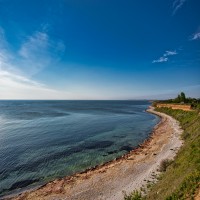 Romania & Bulgaria: Black Sea Coast MigrationSeptember 20 - 29, 2025
Romania & Bulgaria: Black Sea Coast MigrationSeptember 20 - 29, 2025 -
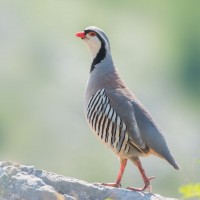 Captivating Croatia: Birding the Adriatic CoastApril 11 - 23, 2026
Captivating Croatia: Birding the Adriatic CoastApril 11 - 23, 2026 -
 Finland & Norway: Birding & NatureJune 4 - 16, 2026
Finland & Norway: Birding & NatureJune 4 - 16, 2026
-
Essential Information +
Pace & Protocols +
Packing List +
Suggested Reading List +
Useful Links +
Photo credits: Banners: Kirk National Park, Pied Avocet, European Bee-eater, Eurasian Eagle-Owl, Skradin, Zitting Cisticola Thumbnails: Eurasian Sparrowhawk, Yellow-legged Gull, Spanish Sparrow, European Bee-eater, Eurasian Scops Owl, Great Crested Grebe, Eurasian Hoopoe, Rock Partridge










































